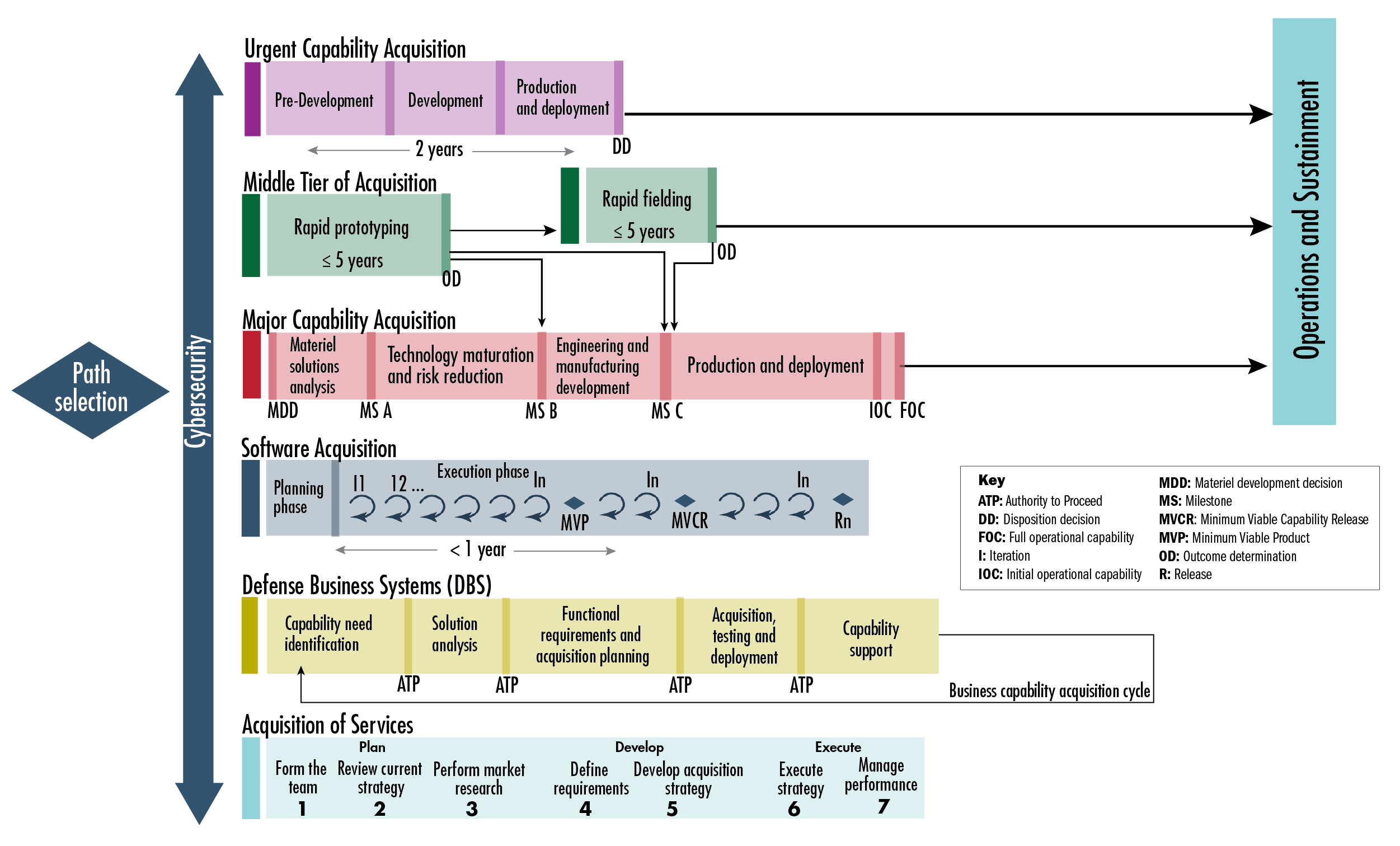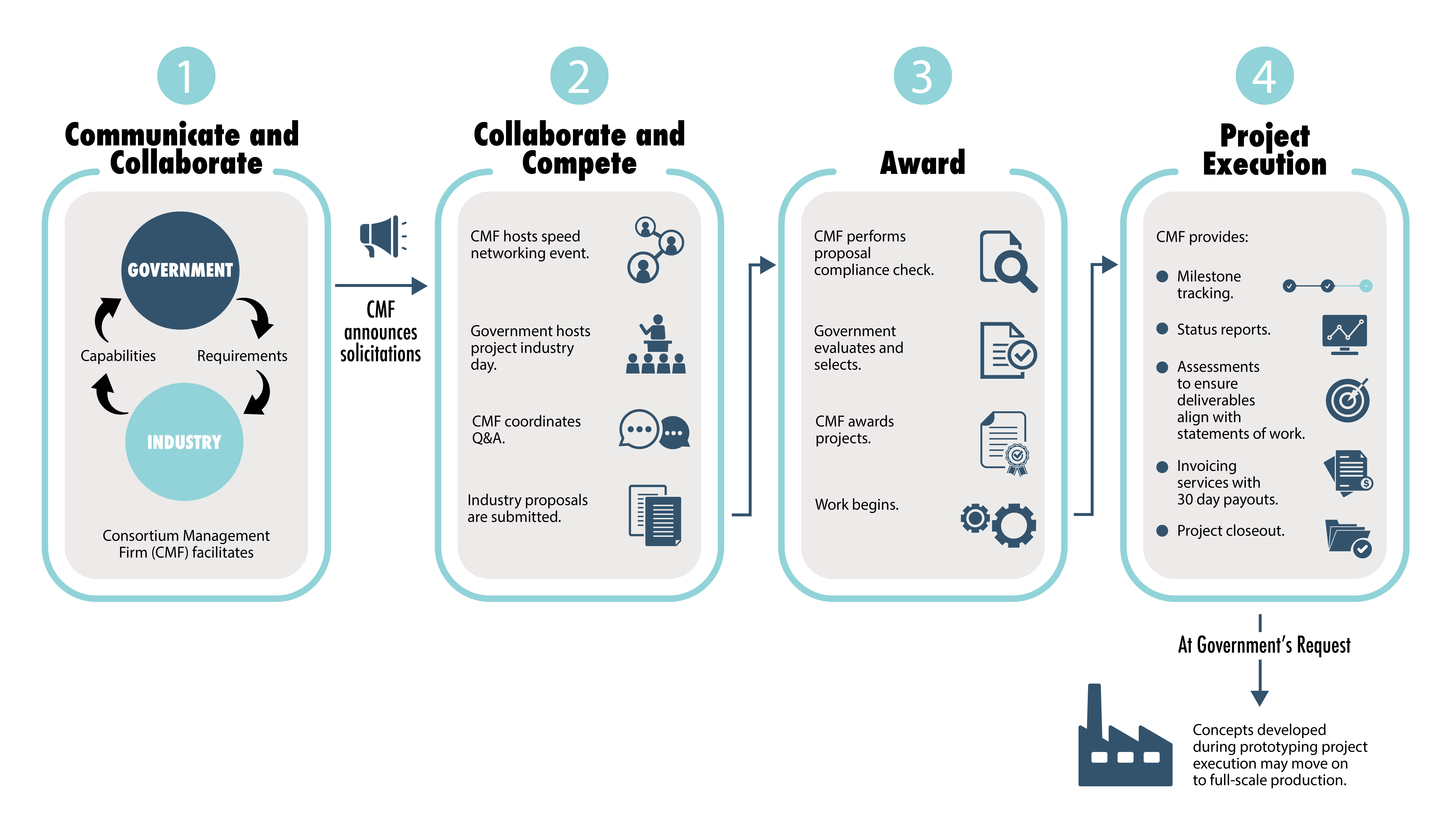
Optimism about Army modernization just might be reasonable, thanks to alternatives to old school, FAR-based acquisition.
by Steve Stark
Army acquisition seems to have changed a great deal since Congress passed the National Defense Authorization Act (NDAA) for fiscal year 2016, when all the talk in acquisition was about reform. That funding bill fundamentally changed things in defense acquisition. It authorized DOD to develop prototype projects that would enhance mission effectiveness and opened the door for the use of other-transaction authority. In that NDAA’s Section 804, it called for middle-tier acquisition and spelled out other acquisition pathways. Overall, the funding measure set in motion many of the trends in alternative acquisition we see today.
Now, the prevailing conversation within Army acquisition is not about reform but about much-needed modernization and innovation. It’s about changes in Army acquisition and process improvements that are starting to show results. It’s about alternative acquisition—or acquisition that doesn’t take half a decade or more for programs to come to fruition. In other words, acquisitions that skip the Federal Acquisition Regulation (FAR), or minimize its involvement.
Among the experts Army AL&T interviewed for this article, some showed genuine optimism about the state of Army acquisition and defense acquisition in general. Others were more cautious. For anyone who’s spent more than a few years working in or around defense acquisition, optimism, cautious or otherwise, is cause to take note.
At the Association of the United States Army’s (AUSA) 2021 Annual Meeting and Exposition in October, on a panel discussion on full life cycle acquisition, Mackenzie Eaglen, a senior fellow at the American Enterprise Institute, said, “I always say to people, you know, you might be surprised. Actually, the Army is doing a lot of great work and innovating.” The optimism feels as though the Army’s acquisition enterprise, after a string of losing seasons, is a home team that’s started to win again. One of the brightest—or at least busiest—spots in alternative acquisition is other-transaction authority. The majority of those deals and dollars—the Army was expected to surpass $12 billion by the end of the 2021 fiscal year—are consortium based, according to the December 2020 report, “Department of Defense Other-Transaction Authority Trends: A New R&D Funding Paradigm?” from the Center for Strategic and International Studies.
THE CONSORTIUM KUMBAYA
Other-transaction authority, which has existed in the shadows of defense acquisition since the late 1950s, enables DOD, for purposes of prototyping and rapid acquisition, to engage in agreements other than traditional contracts. In theory, any small or nontraditional defense contractor could respond to a solicitation for this kind of agreement and win it. Most often, though, a consortium or consortium management company facilitates because it has the expertise in working with the government and has access to that work.

OPTIMISTIC: After nearly three decades in government and quite a few years in industry, Bob Tuohy is bullish on the benefits that the consortium model brings to acquisition.
Bob Tuohy, the chief operating officer emeritus of Advanced Technologies International (ATI), a consortium management company that facilitates other-transaction agreements, said that other transactions “are contracts that don’t fall within the normal procurement rules, so they call them agreements so that people don’t get confused. In the commercial world, these would be contracts just like any other contract.”
The defense acquisition system has unfortunate logical calisthenics built into it—legally mandatory but needlessly complex processes that are confusing, time-consuming and expensive. Tuohy, who worked for the government for nearly three decades, pointed to the government’s cost-accounting standards.
Unlike traditional contractual transactions, other transactions don’t carry with them a need for “any special accounting capabilities,” he said. “The government’s acquisition processes and the DOD’s cost-accounting system is not your normal accounting system and, therefore, organizations [must] create whole new accounting systems in order to comply.” That bureaucracy is, he said, “one of the things that runs off organizations that are very innovative.” When they have a commercial market, they don’t need to work under those conditions with the government.
That’s a problem. Unlike 50 or 60 years ago, the government is no longer funding most of the research and development that’s happening in this country—these innovative technology firms often are. Other transactions and their minimized bureaucracy help make the government a more attractive client.
NEVERTHELESS, ISSUES PERSIST
While other-transaction authority can speed up the acquisition of prototypes and bring nontraditional players into the fold, the Army uses vastly more than prototypes. Other-transaction efforts can only go so far, and the contracting personnel who write up the agreements don’t always get it right. In fact, Tuohy said, there are few incentives for contracting personnel to be inventive or visionary. “The FAR offers a lot of safety for these poor contracting officers who have to be very concerned about sticking their necks out,” he said.
The DOD Inspector General released in April an audit of “a non‑statistical sample of 13 base OT [other-transaction] awards, valued at $24.6 billion that were active in [fiscal years] 2018‑2019.” While it didn’t find evidence of waste, fraud or abuse, it did find some issues. Some of these were probably related to the relative newness of widespread use of other-transaction authority. For example, “the Federal Procurement Data System Next Generation was not set up to track consortium OTs or individual consortium projects and there was no guidance on how to award the projects to a consortium.”
NEAR TO FAR
Where other-transaction authority ends is where FAR-based contracts have to begin. That’s where the revision of the DOD 5000 Instruction series, pushed by then-Undersecretary of Defense for Acquisition and Sustainment (USD A&S) Ellen Lord, and the Adaptive Acquisition Framework (AAF) come in. That framework outlines six “pathways” for acquisition. One of those is the middle tier of acquisition, which, like other transactions, is also intended for prototyping and quick reaction.

BOTH SIDES: An author who retired from the Air Force and now works on the industry side of acquisition, Dan Ward was among those who assisted in the overhaul and streamlining of the DOD 5000 series of instructions and development of the Adaptive Acquisition Framework.
According to Dan Ward, outcome lead for defense acceleration at MITRE Corp.’s Innovation Toolkit team and an acquisition expert who helped develop the framework, “These are all behaviors that reflect a deeper shift in the larger acquisition culture, and that is a shift towards speed, thrift and simplicity.”
In talking about alternative acquisition, Ward said, “The basic premise behind the AAF is there’s more than one way to do acquisitions. And we’re just getting that concept out into the acquisition ecosystem. I think is a tremendous step forward.”
The shift toward alternative acquisition, he said, won’t happen overnight. “Change is hard and change takes time.” Instead of just doing things one way, “being in a situation where you have to choose between alternatives, and then you have to learn from those experiences, and use that to inform your next set of decisions,” leads to real culture change.
According to Ward, the framework tailors contracting to fit six well-known “pathways” to help contracting officers model contracts for a given type of acquisition—from urgent to major acquisition on the materiel side, a software path, a business system path and a path for services.
The old model of tailoring was, Ward said, like making a list of 100 things you have to do, then, “What two or three things are you going to remove? And nobody wants to take their straw off the camel’s back.” In the more adaptive world of the framework, “with middle tier,” Ward said, “it’s very explicitly adopted a tailor-in process.”
Still, other transactions and the AAF are not cures for what ails defense acquisition. That’s a far thornier question.

BOUNDARY CONDITIONS: According to Jon Etherton, an acquisition expert and former Senate staffer, defense acquisition is beset by unfortunate conditions that it can do very little to change and must work around. (Photo by U.S. Marine Corps Systems Command Office of Public Affairs and Communication)
EVENTUALLY, ALL ROADS LEAD TO THE FAR
In many cases, the flaws in the defense acquisition system are features, not bugs. They are intentional. For Jon Etherton, a former Senate staffer and an expert on defense acquisition, those flaws are “boundary conditions,” a term that appeared in the 2014 National Defense Industrial Association (NDIA) report, “Pathway to Transformation,” which Etherton co-authored.
When we think of alternative acquisition, that tends to be other-transaction authority and middle-tier acquisition.
For Etherton, these prototyping mechanisms amount to a “lot of really cool fun stuff,” but it’s all weighted toward the beginning of the process. “Move. Do it quick, and all this kind of thing. But when you talk about doing something to scale, where it becomes a major capability, [it] looks to me a lot like the old system.” Because of the program focus of planning, programming, budgeting and execution (PPBE), everything that gets funded as an official, enduring program has to be a program of record. So, sooner or later, everything has to turn to the FAR.

PATHWAYS TO PROGRESS: The Adaptive Acquisition Framework outlines six “pathways” for acquisition. (Graphic by Defense Acquisition University)
REFORM STILL NEEDED
With the current optimism, is this a pivotal moment in Army acquisition history?
For Eric Lofgren, a senior research fellow at the George Mason University Center for Government Contracting, the answer could be no. We are, he said, at the maximum swing of the pendulum of “that decentralized delegation, speed kind of aspect of the pendulum, and we’re just going to swing right back. That’s the most likely answer.” Which means that, while things seem optimistic at the moment, the system desperately needs a fundamental overhaul.
PPBE, Lofgren said, doesn’t support well the kind of innovation that’s needed today. “Fast-paced innovation requires a focus on training and culture, better supported by organizational budgets” and not program budgets, he wrote in “The DOD Budget Process: The Next Frontier of Acquisition Reform.” Innovation is at the heart of both middle-tier acquisition (MTA) and other-transaction authority (OTA), but in particular, mid-tier doesn’t help a great deal, he said. “There are many issues with MTA and OTA, but the important one here is that they don’t accelerate funding. For example, MTA was passed in the [fiscal year] 2016 NDAA along with a Rapid Prototyping Fund that was supposed to provide a ready pool of funding—but the fund no longer exists. So even if you can get an MTA-to-requirement lineup within a few months and move to an OTA contract, you still have to wait three to five years after an approved requirement to work money into the president’s budget.”
In a July policy brief from the Center for Security and Emergency Technology, “Ending Innovation Tourism,” authors Melissa Flagg and Jack Corrigan took DOD to task for acting like “innovation tourists” rather than having a coherent, overarching innovation strategy. “Solving the military’s technology-adoption problem is impossible without an overhaul of its acquisition process,” they wrote, “and the realities of our present political and national security environment will likely prevent lawmakers from enacting such broad-based reforms in the near term. In the meantime, a major near-peer competition is in full swing. The DOD must act immediately to implement a true innovation strategy using the authorities it currently has at its disposal.”
In discussions at the AUSA meeting in October, that phrase, “innovation tourism,” came up more than once, with panel members disagreeing that it was accurate.
But it is unarguably the case that PPBE is not built to facilitate innovation, at least not technological innovation at the speed that needs to happen today. That system was supposed to go into place in about 1950, Lofgren noted in an October interview with Army AL&T, but the Korean War put that plan on hold. When he became defense secretary in 1961, Robert McNamara adopted program budgeting. For Lofgren, the PPBE system represented “a radical break from your liberal [democratic] traditions, and it was actually an instantiation of Soviet planning methodologies. And now we just take that for granted. We don’t realize how antithetical” that is to the traditional American way of doing business, he said.

SAME OLD: For acquisition expert Eric Lofgren, until the Soviet-style PPBE system goes away, defense acquisition is not going to be as conducive to innovation as the acquisition system needs to be. (Photo by Stephen Gosling)
PATHWAY LESS TRAVELED
In his writing, Lofgren is advocating not for improving PPBE, but for seeking an alternative for resource allocation that is informed by commercial practices, international norms and the traditions of financial management in the United States. So many of the ills that afflict acquisition, he said, stem from the system being centered not on funding the organization developing the program, but on the program itself. Doing away with that program-focused system would do away with a great deal that’s familiar to most in acquisition, starting with requirements, the program objective memorandum, and much more. Indeed, dropping the program focus would very dramatically change the face of acquisition as we know it.
Too often, Eaglen observed at that AUSA forum, the services spend years developing new operating concepts and then going to industry to look for technology to support their ideas, rather than looking at existing technology and developing operational concepts around that. She cited as exemplary the development of the Integrated Visual Augmentation System (IVAS), with the Army using middle-tier acquisition and working directly with the contractor—with Soldiers and coders working side by side.
“What innovation means and what it can do is often misunderstood,” Eaglen said. “Uber … there were already drivers and there were already cars and there were already taxis, they just had to get the technology to totally upend a traditional system.”
With most traditional prime contractors structured around the incentives created by PPBE, it is unlikely that they will eagerly support its demise. But Lofgren isn’t advocating for its wholesale ouster. Instead, he’s arguing, “Any change should move deliberately.” One of the first steps to increasing budget flexibility, he said in a November email exchange, “is to improve program reporting and analysis so that the department can build trust with its stakeholders.”
Lofgren is not alone. Both armed services committees, in their versions of the National Defense Authorization Act for the 2022 fiscal year, have earmarked funding for a commission to study the PPBE system, Lofgren said.

SINGLE POINT OF COORDINATION: The consortium management firm facilitates interaction between industry and government, which in turn generates competition and collaboration. During all of this, the consortium management firm conducts all of the back-office functions for its member businesses. (Graphic by Advanced Technologies International)
CONCLUSION
In the end, optimism about Army acquisition comes from the Army’s own determination to do a better job of solving difficult problems. It stood up Army Futures Command, the biggest change in Army structure since the 1970s. It argued for Congress to push OSD to delegate decision-making downward to the lowest level practical. With the new authorities in contracting that Congress has given DOD, the revision of the 5000 series by OUSD (A&S) and creation of a concretely tailored middle tier of acquisition—all of this has converged to create a sense of strong forward motion.
For those accustomed to the Army forever talking about innovating but still flying helicopters and driving tanks designed in a different century, it may seem surprising that there is real innovation going on. The Army’s xTechSearch program, developed by the Office of the Assistant Secretary of the Army for Acquisition, Logistics and Technology, is actively helping nontraditional contractors work with the Army. Through that program, and with the help of creative thinking, the Army has uncovered some highly useful technologies. It’s a savvy way to find innovation, but it remains at the small scale.
The next few years will begin to see either the fielding of the Army’s priority programs or their cancellation. No one expects everything to go perfectly. But nonetheless, expectations are high.
For more information on how defense acquisition works, go to https://tinyurl.com/km4kpt2s.
STEVE STARK is senior editor of Army AL&T magazine. He holds an M.A. in creative writing from Hollins University and a B.A. in English from George Mason University. In addition to more than two decades of editing and writing about the military, science and technology, he is, as Stephen Stark, the best-selling ghostwriter of several consumer health-oriented books and an award-winning novelist.







